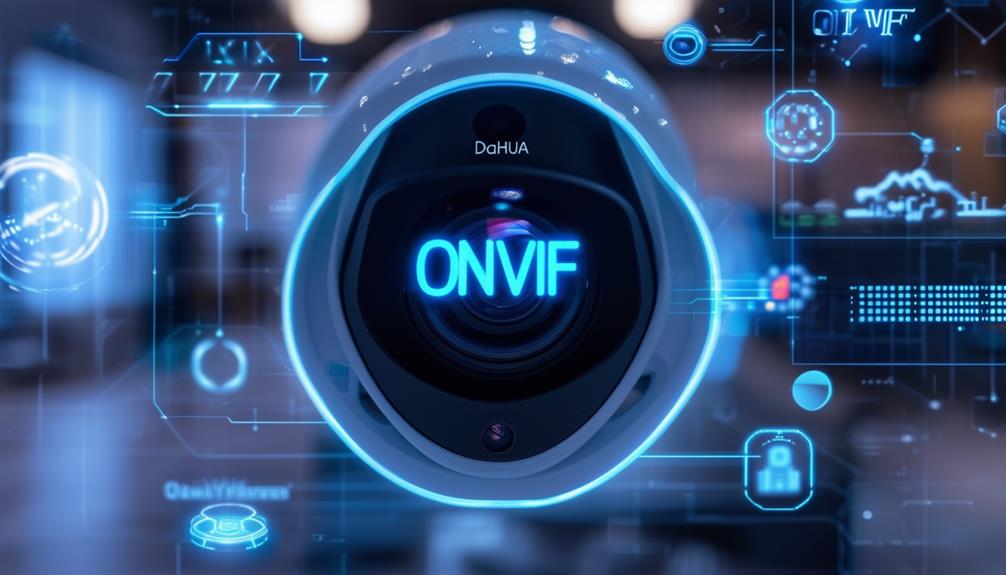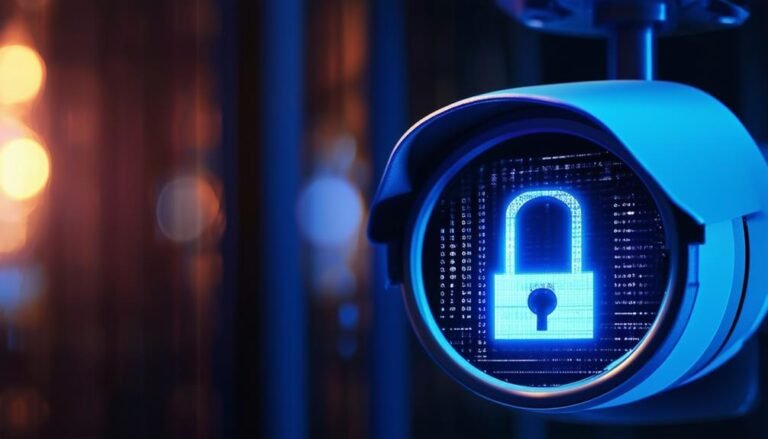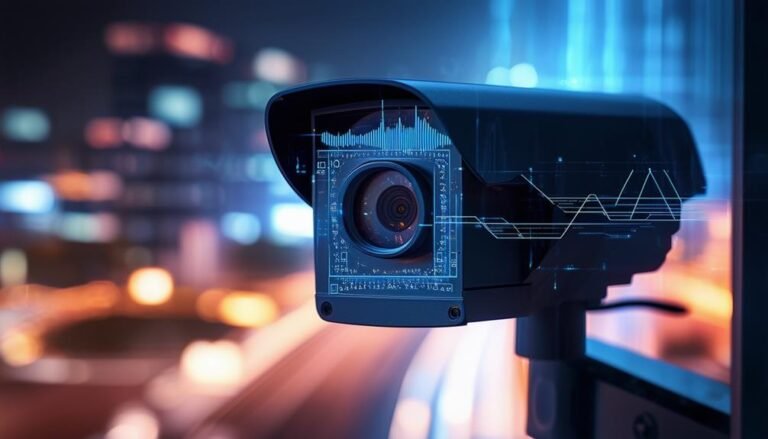To enable ONVIF on your Dahua camera, start by logging into its web interface using the camera's IP address. Navigate to the "Network" settings and find the "ONVIF" section. Toggle the ONVIF option to "Enabled" and set a unique username and strong password for your ONVIF access—make sure it's different from your admin credentials. Save your settings and restart the camera to apply the changes. Once that's done, test the connection with ONVIF-compatible software to confirm functionality. Keep going to discover more steps for ideal setup and troubleshooting.
Understanding ONVIF Protocol
Understanding the ONVIF protocol is crucial for anyone looking to streamline their IP camera setup. This open standard gives you the freedom to integrate various security devices from different manufacturers without being locked into a single brand. ONVIF, which stands for Open Network Video Interface Forum, fundamentally guarantees that your cameras, encoders, and software can communicate seamlessly with one another. It's like having a common language for all your devices, making it easier to manage your security system.
When you embrace the ONVIF protocol, you're not just setting up cameras; you're creating a flexible, adaptable network that can grow with your needs. You have the power to mix and match devices, allowing you to choose the best options based on your specific requirements rather than being confined to a limited selection. This kind of freedom is invaluable, especially in a world where technology evolves rapidly.
Moreover, ONVIF simplifies configuration and management. You won't have to spend countless hours sorting through compatibility issues or dealing with proprietary software. Instead, you can focus on what truly matters: protecting your space.
Checking Camera Compatibility
Before you immerse yourself in enabling ONVIF on your Dahua camera, it's essential to check its compatibility. Not all Dahua models support the ONVIF protocol, and ensuring your camera is compatible can save you a lot of time and frustration down the line. Start by looking up your camera model online. You can find detailed specifications on Dahua's official website or in the documentation that came with your device.
Look for any mention of ONVIF support in the specifications. If it's listed, you're in the clear! If you're unsure, you might also find user reviews or forums helpful, as other users often share their experiences regarding compatibility.
Next, you should check the firmware version of your camera. Sometimes, even if a model supports ONVIF, it might not work correctly if the firmware isn't up to date. Access your camera settings via the IP address in your web browser to see the firmware version. If it's outdated, consider updating it before proceeding.
Lastly, if you've got multiple Dahua cameras in your setup, double-check each one for ONVIF compatibility. Just because one model works doesn't mean all will. Once you've confirmed your camera is compatible, you'll be ready to engage in the enabling process with confidence. Remember, a little preparation goes a long way in ensuring your surveillance system operates seamlessly.
Accessing Camera Settings
To access your Dahua camera settings, you'll need to start by entering its IP address into a web browser. This is your gateway to customizing and optimizing your camera's functionality. Make certain your computer or device is connected to the same network as your camera. Once you've entered the IP address, hit enter, and you'll be greeted with a login screen.
You'll need to enter your username and password to gain access. If you haven't changed these defaults, they're often set to admin/admin for many Dahua cameras. However, for security reasons, it's wise to change this as soon as you log in. After entering your credentials, you'll be taken to the camera's main settings interface.
From here, you'll have the freedom to explore various settings. You can adjust video quality, frame rates, and even the camera's viewing angle depending on the model. The interface is generally user-friendly, allowing you to navigate through different options with ease. If you're looking to customize alerts or notifications, you'll find that here too.
Don't forget to save any changes you make! This is essential to guarantee that your adjustments take effect. If at any point you feel lost, most Dahua cameras come with a help section, or you can consult the user manual. Enjoy the process of making your camera work exactly how you want it to—it's all about enhancing your surveillance experience!
Navigating to Network Settings
Once you're in the camera's main settings interface, finding the Network Settings is straightforward. Look for a menu that probably has a label like "Network" or "Network Configuration." This is typically located on the left side of the screen or sometimes in a dropdown menu, depending on your camera's firmware version.
Click on it, and you'll be taken to a new page that lays out various network options. Here, you can explore everything related to your camera's connectivity, like IP settings, DHCP options, and even port configurations. It's important to familiarize yourself with these settings, as they'll give you the freedom to customize how your camera interacts with your network.
If your camera is connected to a network, you might see a summary of the current network status right away. This can include the IP address, subnet mask, and gateway information. If you want to make any changes, like switching between static IP and DHCP, you'll find the options here.
Navigating through these settings can feel empowering, letting you take control of your surveillance setup. Remember, each camera model might have slight variations in menu layout, but the essence remains the same. Just keep an eye out for anything labeled "Network" or "Internet," and you'll be well on your way to optimizing your camera for seamless operation within your network.
Enabling ONVIF Option
Enabling the ONVIF option on your Dahua camera is a key step in enhancing its compatibility with various network video recorders (NVRs) and third-party surveillance systems. This feature allows you to connect your camera seamlessly with different devices, giving you the freedom to choose the best surveillance solution for your needs.
To enable the ONVIF option, start by logging into your camera's web interface. You'll typically do this by entering the camera's IP address into your web browser. Once you're in, head to the "Network" settings menu. Look for the "Advanced" or "ONVIF" section, which is where you'll find the option to enable ONVIF protocol.
Simply toggle the ONVIF option to "Enabled." You might also see additional settings related to the ONVIF functionality, like the ability to set the port number or adjust other network configurations. Make sure to note these settings, as they can be vital for future integrations with your NVR or other software.
After you've enabled the option, don't forget to save your changes. This step is essential; otherwise, your settings won't take effect. Once saved, your Dahua camera should be ready to communicate with ONVIF-compliant devices. By taking this step, you're ensuring that your surveillance system can grow and adapt as your needs evolve, giving you the flexibility and control you desire. Enjoy the peace of mind that comes with a fully integrated security system!
Configuring ONVIF Credentials
Configuring ONVIF credentials is vital for guaranteeing secure communication between your Dahua camera and any connected devices. Without the right credentials, you risk unauthorized access and potential security breaches. To start, log into your Dahua camera's web interface using your admin credentials. Once you're in, navigate to the settings menu. Look for the "Network" section, and then find the "ONVIF" settings, where you'll enter the necessary credentials.
You'll typically set a username and password specifically for ONVIF access. It's important to choose a strong password that combines letters, numbers, and special characters to enhance security. Make sure it's different from your admin password to add another layer of protection. After entering your desired username and password, save the changes. This enables the camera to authenticate any connecting devices, guaranteeing that only authorized accesses can occur.
Once you've configured your ONVIF credentials, you can also review additional settings like user permissions. This allows you to customize what different users can access, giving you greater control over your security setup. You'll want to guarantee that only trusted devices and users can view or manage the camera feeds.
Lastly, remember to document your credentials securely. This way, you'll have them on hand when connecting your camera to various ONVIF-compatible devices. With the right configuration, you can enjoy the freedom of accessing and managing your security system without compromising on safety.
Testing ONVIF Connection
Now that you've configured your ONVIF credentials, it's crucial to test the connection to verify everything's working properly. Start by verifying your camera's compatibility and then use the ONVIF Device Manager for a straightforward check. Don't forget to confirm your network settings, as they can impact the connection as well.
Verify Camera Compatibility
Ensuring compatibility is crucial when testing the ONVIF connection on your Dahua camera. You want to make sure that your camera supports the ONVIF profile you're planning to use. Check the specifications in your camera's manual or on the manufacturer's website for details on supported profiles like Profile S, G, or T.
Next, confirm the firmware version. Sometimes, updates can improve compatibility or enable new features. Keeping your camera's firmware up-to-date not only enhances security but also boosts performance.
Then, connect your camera to a network with a reliable internet connection. This guarantees that your testing environment is stable and less prone to interruptions. It's also a good idea to use a wired connection if possible, as it generally provides better performance than Wi-Fi.
Lastly, consider running a simple ping test to verify that your camera is reachable on your network. If you can access your camera's IP address without any hiccups, you're one step closer to establishing a successful ONVIF connection. With everything in check, you're now ready to proceed to the next phase of connecting with ONVIF-enabled devices.
Use ONVIF Device Manager
To test the ONVIF connection on your Dahua camera, start by downloading and installing the ONVIF Device Manager (ODM). This handy tool lets you see if your camera is ready to embrace the freedom of ONVIF compatibility. Once you've got it installed, follow these steps to test your connection:
- Launch the ODM: Open the ONVIF Device Manager and let it scan your network. This process reveals all ONVIF-compatible devices within reach, including your Dahua camera.
- Select Your Camera: When your camera appears on the list, click on it. You'll be prompted for your camera's username and password, so have those handy.
- Check the Connection: After entering your credentials, hit the "Connect" button. If all goes well, you should see your camera's live feed, indicating a successful ONVIF connection.
With these steps, you're not just testing a connection; you're embracing the potential for seamless integration and control. Enjoy the freedom that comes with knowing your Dahua camera is ONVIF-ready!
Check Network Settings
Your Dahua camera's network settings play an essential role in establishing a successful ONVIF connection. To guarantee everything's set up correctly, start by checking the IP address of your camera. It should be on the same subnet as your ONVIF-compatible software or device. If it's not, you'll need to adjust the settings in the camera's web interface.
Next, verify the subnet mask and gateway settings. They should match your network configuration to avoid connection issues. If you're unsure, consult your router's settings or ask your network administrator for assistance.
Don't forget to check your firewall settings as well. Sometimes, firewalls can block the ONVIF port, preventing connections from being established. Make sure the necessary ports are open, typically port 80 for HTTP and 8080 for ONVIF.
Lastly, if you're using Wi-Fi, verify your camera is connected to the right network. After confirming all these settings, you can test the ONVIF connection using tools like ONVIF Device Manager. This way, you'll know if everything's functioning smoothly, giving you the freedom to monitor your space without hassle.
Troubleshooting Common Issues
When you're having trouble with your Dahua camera's ONVIF connection, it helps to start by identifying common connection problems. Make certain to check your configuration settings and confirm everything's set up correctly. If issues persist, you might need to update the firmware to guarantee compatibility.
Connection Problems Overview
Connection problems with Dahua cameras can be frustrating, especially when you're keen to access their features like ONVIF. You want the freedom to monitor your space seamlessly, but issues can hinder that experience. Here are some common connection problems you might face:
- Network Configuration: If your camera isn't on the same network as your viewing device, you won't be able to connect. This can feel like a wall between you and your surveillance freedom.
- Firewall Restrictions: Sometimes, firewalls can block the camera's communication. This can create a sense of confinement, limiting your access to essential security features.
- Power Supply Issues: A faulty power connection can lead to intermittent connection problems. It's maddening when you realize your camera isn't functioning due to something as simple as power.
When facing these issues, remember that you're not alone. Many users experience similar challenges, and addressing these connection problems can lead to the freedom and peace of mind you desire. Stay determined, and soon you'll be enjoying all the capabilities of your Dahua camera!
Configuration Settings Check
Resolving connection problems often leads to a need for a thorough check of your camera's configuration settings. It's crucial to verify everything's configured properly for your Dahua camera to work seamlessly with ONVIF. Here's a quick checklist to help you troubleshoot common issues:
| Configuration Setting | Recommended Action |
|---|---|
| IP Address | Ensure it's unique and not conflicting with other devices. |
| Subnet Mask | Confirm it matches your network settings. |
| Gateway | Check it's correctly set to your router's IP. |
| ONVIF Port | Verify that the default port (usually 8080) is open and not blocked. |
| User Credentials | Double-check your username and password for accuracy. |
After confirming these settings, restart your camera and try reconnecting. If you still face issues, consider checking your network configuration or consulting your camera's manual. Remember, having the right settings not only gives you more freedom to access your camera but also enhances your security experience. Don't hesitate to reach out to tech support if problems persist; they can provide tailored assistance.
Firmware Update Requirements
To guarantee your Dahua camera operates effectively with ONVIF, keeping your firmware updated is essential. Regular updates assure not just compatibility but also security and performance enhancements that can make a real difference in your surveillance experience. Here are a few key reasons to keep your firmware current:
- Enhanced Security: Outdated firmware can leave your camera vulnerable to cyber threats. Updating regularly helps protect your freedom and privacy.
- Improved Functionality: New features and fixes in firmware updates can release your camera's full potential, giving you the tools you need to monitor your space effectively.
- Better Compatibility: As ONVIF standards evolve, staying updated assures your camera works seamlessly with other devices and software, granting you the versatility you crave.
Before you start the update process, check your current firmware version through the camera's settings. If it's outdated, download the latest version from Dahua's official website. Remember, a well-maintained camera enhances not only your surveillance capabilities but also your peace of mind, allowing you to enjoy the freedom of knowing your property is protected.
Frequently Asked Questions
What Is the Main Purpose of the ONVIF Protocol?
The main purpose of the ONVIF protocol is to promote interoperability among IP-based security devices. It lets you connect various cameras and recording systems from different manufacturers, so you aren't locked into one brand. With ONVIF, you can mix and match devices to create a tailored security system that meets your needs. This flexibility empowers you to choose the best technology without restrictions, ensuring you have the control and freedom you desire.
Can I Use ONVIF With Non-Dahua Cameras?
Yes, you can use ONVIF with non-Dahua cameras! In fact, about 70% of IP cameras on the market support the ONVIF standard, giving you plenty of options for flexibility. This interoperability lets you mix and match devices from different brands, so you're not locked into one system. Just check the camera's specifications to verify it's ONVIF compliant, and you'll enjoy the freedom to create a surveillance setup that fits your needs perfectly.
Is a Firmware Update Required to Enable ONVIF?
You might not need a firmware update to enable ONVIF, but it really depends on your camera's current version. Sometimes, manufacturers release updates to enhance compatibility and fix bugs, so it's a good idea to check for any available updates. If you're experiencing issues, updating your firmware could resolve them. Ultimately, staying up-to-date helps guarantee your devices work seamlessly together, giving you more freedom in choosing your security setup.
How Can I Reset My Dahua Camera Settings?
Imagine standing before your Dahua camera, ready to reclaim its original settings. To reset it, find the small reset button, often hidden like a secret treasure. Press and hold it for about 10 seconds until the lights blink—like a firework signaling a new start! Once released, your camera's settings will revert to factory defaults, giving you the freedom to set it up anew, tailored to your needs and vision. Enjoy the adventure!
What Should I Do if ONVIF Fails to Connect?
If Onvif fails to connect, don't panic! First, check your network settings to guarantee everything's configured correctly. You might want to verify the camera's IP address and ascertain it's on the same network as your device. Restart both the camera and your connection device. If that doesn't work, consider updating the firmware of your camera. Finally, consult the user manual for troubleshooting tips specific to your model. Freedom in tech starts with knowledge!



